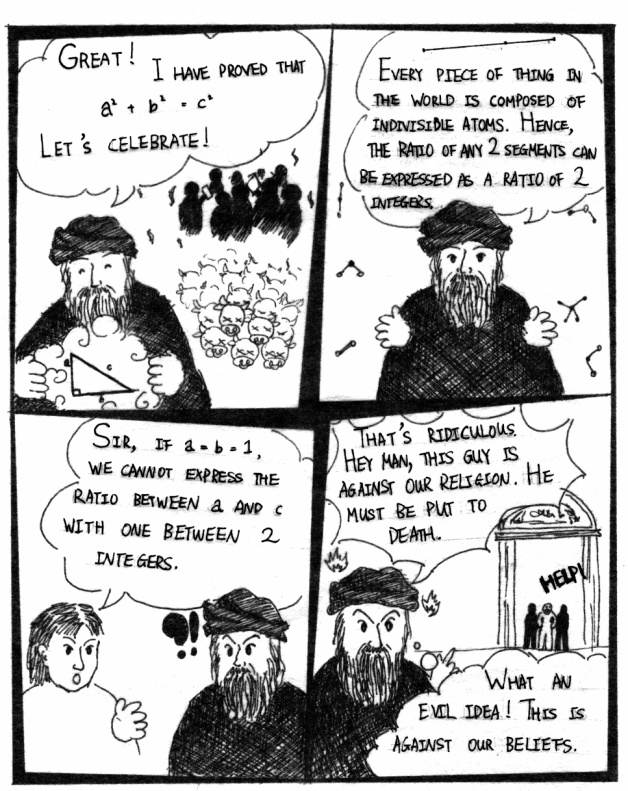월별 글 목록: 2008년 2월월
Mathematical Database – Math Funland – Math Comic
Help
How to use GDP?
How to draw a point?
The ‘Point’ button can be used to construct free points, semi-free points (on straight lines or circles) as well as determining intersection points between lines, between circles or between lines and circles. Under the ‘Select’ mode, free points and semi-free points can be dragged.
How to draw a straight line?
Straight lines can be constructed using the ‘Segment’ button. By double-clicking the ‘Segment’ button, we get the ‘Ray’ and ‘Line’ buttons.
How to draw a circle?
The ‘Circle’ button can be used to construct circles. This can be done by fixing a centre and a point on the circumference. These points can be given points or new points.
How to label points, lines and circles?
Using the ‘Label’ button, the positions of the labels can be adjusted. The labels can be renamed by double-clicking on them.
List of objects
The ‘Object List’ button can be used to show (or hide) the list of objects.
Others
- Hold the ‘Shift’ key to select more than one objects at the same time.
- Press ‘H’ to hide a selected object. Another way to do this is to double-click a selected object.
- Press ‘Del’ to delete a selected object. Note that this will also delete all objects that have been built upon the deleted object.
- The arrow keys on the keyboard can serve as substitutes to the scroll bars. This may be necessary to adjust the position of the screen in the process of drawing straight lines or circles.
Mathematical Database – Math Funland – Math Comic

Pythagoras (around 569 to 500 BC) proved the Pythagoras’ Theorem and celebrated the event by killing one hundred cows. Thus the Pythagoras’ theorem was also called the “Hundred Cows Theorem”. On the other hand, as everyone at that time knew that every piece of matter in the world is composed of indivisible atoms, Pythagoras proposed that the ratio of any segments could be expressed as the ratio of two integers (we now call this “rational number”). And this became an axiom at that time. Later, one of his followers, Hippasus, pointed out that in a right-angled triangle of unit side lengths, the ratio of the adjacent side to the hypotenuse could not be expressed as the ratio of two integers. As this was contrary to the beliefs of the mathematicians at that time, the incident was named the first mathematics crisis in history. Although Hippasus was executed, Pythagoras had to admit the existence of “irrational numbers”. It was only until 2000 years later that the “irrational numbers” were defined using the concept of “rational numbers”.
Mathematical Database – Math Funland – Math Comic
Mathematical Database – Math Funland – Math Comic
Mathematical Database – Math Funland – Math Comic
「數學資料庫」徵文及漫畫比賽 2005/06 詳情
- 參賽組別:
- 文章組別:分初中組(中一至中三)及高中組(中四至中七)
- 漫畫組別:公開組(中一至中七)
- 參賽作品形式︰
- 文章組別:作品以文字為主,亦可附以插圖。
- 漫畫組別:作品以漫畫形式表達,當中可包括對話,亦可附以簡單文字說明。
- 文字應以中文或英文為主,中英文並用亦可。使用中文者需盡量使用書面語,以方便讀者閱讀。字數不限。
- 參賽者可自訂題目,程度不限,惟作品內容必須和數學有關。
- 有關作品的題材,參賽者可參考「數學資料庫」網頁(http://www.mathdb.org)上的「數學文章」、「數學漫畫」(於「數學趣趣地」部分)及 2004/05 年度徵文比賽的得獎作品。
- 作品規格:
- 作品可以電子檔案或書面形式遞交。
- 電子檔案:文章作品可以 Microsoft Word、Quick Word 或 Open Office 等文書處理程式儲存成 .doc 或 .txt 檔(.doc 檔為宜),圖片可嵌入 .doc 檔中或另存成 .jpg 格式。漫畫作品可以 .gif、.jpg、.bmp、.png 格式儲存。兩組作品亦可以 .pdf 格式遞交。參賽者可以電子形式遞交作品,亦可把作品燒錄在一隻 CD/DVD 光碟上並郵寄方式遞交(詳見「遞交作品方法」)。漫畫作品將列印在一張 A4 紙上作評審。
- 書面形式:文章作品以黑色或藍色原子筆整齊地書寫於 A4 大小的紙張上,或以電腦打印在 A4 紙上(如參賽者不懂得在電子檔案中輸入數學符號,亦可在電腦打印的文件上輔以手寫的數學符號)。漫畫作品畫在一張 A4 大小的紙張上,顏色不限,或以電腦打印在一張 A4 紙上。
- 參賽者遞交作品時必須附以參賽表格(可於「數學資料庫」網上填寫或下載),每隊參賽者的每份作品均需填寫表格一份。
- 作品可以電子檔案或書面形式遞交。
- 遞交作品方法:
- 以電子形式遞交:請填寫「數學資料庫」網上參賽表格並上載作品。亦可將參賽作品連同參賽表格電郵至本網站的徵文比賽專用郵箱 essay@mathdb.org。作品總容量不得大於 10MB。
- 以郵寄形式遞交:請將參賽作品連同參賽表格或載有參賽作品和表格的 CD/DVD 光碟郵寄至以下地址。
寄:新界沙田 香港中文大學數學系 數學英才精進課程 轉交:數學資料庫(徵文及漫畫比賽 2005/06)
本網站會在收到作品後 10 日內以電郵回覆作實。
- 截止日期為 2006 年 2 月 28 日(星期二)香港時間下午 5 時,以郵戳日期(若以書面形式遞交)或電郵/「數學資料庫」伺服器顯示的時間(若以電子形式遞交)為準。
- 作品評審:
- 評審準則:內容方面能對所述的數學課題展示深入和獨到的見解,具思考性和啟發性,而能以深入淺出、生動有趣方法表達,對一般讀者具吸引力。
- 評判團包括以下成員: 區國強教授(香港中文大學數學系) 李健賢教授(香港科技大學數學系)
蕭文強教授(香港大學數學系)
- 賽果公佈:
- 比賽結果將於 2006 年 4 月於「數學資料庫」網頁(http://www.mathdb.org)公佈。
- 頒獎禮將於 2006 年 5 月舉行,詳情亦將於「數學資料庫」網頁公佈。
本比賽將另函通知得獎者所屬的學校。
- 獎項︰ 每組均設有冠、亞、季軍及三至五個優異獎。獎品如下: 冠軍: 500 元書券 及 精美禮品一份 亞軍: 300 元書券 及 精美禮品一份 季軍: 200 元書券 及 精美禮品一份 優異獎: 100 元書券 及 精美禮品一份
- 其他比賽細則︰
- 個人或團體(不超過六人)參賽皆可,每位參賽者於每個組別只限遞交作品一篇(可同時參加文章和漫畫組別,各遞交作品一份)。以團體參加文章組別時,以組員的最高級別決定參賽組別為高中或初中組。例如一名中三和一名中四學生組隊參賽,則以高級組論。
- 作品必須由參賽者原創(若引用其他作品必須加以註明),並且未經任何形式在公眾報刊、比賽或網絡等場合公開發表。
- 以電子格式及 CD/DVD 光碟形式遞交的作品恕不發還。至於以書面格式遞交的作品,如參賽者希望在比賽後發還,請隨函附上回郵信封及足夠的郵票,否則本網站有權不受理。
- 本網站有權要求得獎者提出適當的就讀年級證明。
- 得獎作品的版權由參賽者及本網站共同擁有。
- 本網站有權將得獎作品作適當修改及在本網站上發布。
- 若有參賽者違反上述規則,本網站有權取消其參賽資格。
- 「數學資料庫」成員不得參加是次比賽,以示公允。
- 如有任何疑問,歡迎電郵至 essay@mathdb.org 查詢。